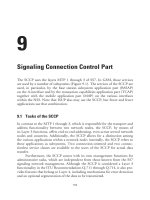Signaling Connection Control Part
Bạn đang xem bản rút gọn của tài liệu. Xem và tải ngay bản đầy đủ của tài liệu tại đây (254.6 KB, 17 trang )
9
Signaling Connection Control Part
The SCCP uses the layers MTP 1 through 3 of SS7. In GSM, those services
are used by a number of subsystems (Figure 9.1). The services of the SCCP are
used, in particular, by the base station subsystem application part (BSSAP)
on the A-interface and by the transaction capabilities application part (TCAP)
together with the mobile application part (MAP) on the various interfaces
within the NSS. Note that ISUP also may use the SCCP, but fewer and fewer
applications use that combination.
9.1 Tasks of the SCCP
In contrast to the MTP 1 through 3, which is responsible for the transport and
address functionality between two network nodes, the SCCP, by means of
its Layer 3 functions, offers end-to-end addressing, even across several network
nodes and countries. Additionally, the SCCP allows for a distinction among
the various applications within a network node; internally, the SCCP refers to
these applications as subsystems. Two connection-oriented and two connec-
tionless service classes are available to the users of the SCCP for actual data
transfer.
Furthermore, the SCCP comes with its own management functions for
administrative tasks, which are independent from those known from the SS7
signaling network management. Although the SCCP is considered a Layer 3
functionality in the ITU Recommendations Q.711 through Q.714, it also pro-
vides features that belong to Layer 4, including mechanisms for error detection
and an optional segmentation of the data to be transmitted.
153
9.1.1 Services of the SCCP: Connection-Oriented Versus Connectionless
The SCCP offers two connection-oriented and two connectionless service
classes to its users. The difference between the two is as follows. Two network
nodes establish a virtual connection between the two subsystems for transaction
1, 2, or 3, in case of the connection-oriented mode. The identification of the
connection is achieved via reference numbers, the source local reference (SLR)
and the destination local reference (DLR). While such a connection is active, it
is possible not only to exchange data between the two network nodes but also
to address individual transactions.
Figure 9.2 illustrates this relation. The SCCP analyzes the data received
from the MTP and forwards the data to the addressed subsystem, where the
input data is associated with the various active transactions. Typical examples
in GSM for connection-oriented transactions are a location update and a MOC
within the BSSAP.
In the case of connectionless service classes, the SCCP provides no refer-
encing; the recipient of a message must assign it to an active process. Examples
for connectionless applications are PAGING in the BSSAP, SCCP manage-
ment, and the TCAP protocol.
Distinguishing between connection-oriented and connectionless service
within the SCCP is achieved by a parameter called the protocol class (described
in Section 9.3.2.5).
9.1.2 Connection-Oriented Versus Connectionless Service
The difference between connection-oriented and connectionless service can
best be explained by the example of sending a letter. The postal service provides
the physical means for mail transfer. The individual envelopes correspond to
154 GSM Networks: Protocols, Terminology, and Implementation
SCCP
BSSAP
TCAP
MAP
ISUP
Layer 4–7
Layer 3
Figure 9.1 The SCCP as a platform for various users.
the MSUs, and the letter inside the envelope corresponds to the SCCP message
(Figure 9.3).
9.1.2.1 Connection-Oriented Service
When two parties of any particular company correspond via mail, they typi-
cally address many issues. References for each issue need to be assigned, so
the recipient can distinguish among them. That corresponds to a virtual
Signaling Connection Control Part
155
MTP
MTP
SCCP
Subsystem
Transaction 1
Transaction 2
Transaction 3
Subsystem
Transaction 1
Transaction 2
Transaction 3
SCCP
MTP
Network node 2Network node 1 Network node 3
Figure 9.2 Connection-oriented services of the SCCP.
Envelope Message signal unit (MSU)
SCCP—Message
Letter
Reference
SLR
DLR
Figure 9.3 The task of SLR and DLR.
connection setup. The various issues that arise could be an unpaid bill or a new
order. Each side tries to make the issue clear, for example, by adding a headline
or a reference line to establish a unique reference. The function of the reference
corresponds to the task of SLR and DLR of connection-oriented services in the
SCCP. A virtual connection between sender and recipient is set up in both
cases. “Virtual” here means that no permanent, dedicated physical path
between the two parties exists.
9.1.2.2 Connectionless Service
A person who vacations in a faraway country typically sends postcards to rela-
tives and friends. Each postcard needs an address to enable delivery, but there is
no reference to a specific issue and no answer is expected. It is, therefore, a con-
versation that does not require an immediate reference or a connection setup.
This comparison is valid only for the SCCP itself. The recipient has the
opportunity to include a reference in the data part of the message and hence
establish a relation to an issue, even when using the connectionless service
classes. (An example is provided in Chapter 11.)
9.2 The SCCP Message Format
The complete SCCP message is hosted, together with the routing label by the
SIF of an MSU (Figure 9.4). Only the identifier for the user part SCCP is car-
ried in the SIO outside the SIF. The SCCP is the immediate layer above the
MTP, and a wide variety of messages with different formats and tasks are
defined for the SCCP. The peculiarities of the SCCP message format will be
explained first; the single messages are then described in more detail. Figure 9.5
presents the general format of a SCCP message.
SCCP messages consist of the following parts (refer to Figures 9.4 and 9.5):
156 GSM Networks: Protocols, Terminology, and Implementation
FCS
Signaling connection control part (SCCP)
Message signal unit (MSU)
LI
BSNFSN
BIB
FIB
Flag
Flag
SIOSIF
length
length
Parameter B
Parameter C
Routing label
SCCP
message
Parameter A
Pointer
Figure 9.4 The MSU as the transport frame for the SCCP.
SignalingConnectionControlPart
157
MandatoryfixedparameterA–N
MandatoryvariableparametersAandB
OptionalparametersAandB
Pointertothestartoftheoptionalpart
PointertothestartofmandatoryparameterB
PointertothestartofmandatoryparameterA
length
length
name
name
length
length
Param. A
Param. B
Optional
Par. A
Optional
Par. B
MSU
end
{
{
{
Endoftheoptionalparameters
MSU—Header
Message
type
00
Param. A
Param. B
Param. N
Figure 9.5 General format of an SCCP message.
•
Mandatory fixed part. The parameters of this part are mandatory and
of fixed length, and their order is fixed. That allows omission of an
identifier for the parameter as well as a length indicator.
•
Mandatory variable part. The parameters of this part are mandatory
and their order is fixed; however, their length may vary, depending on
the situation. Again, no identifier is necessary, but a length indicator is
required to determine the parameter’s position in the message. The
length indicator uses an additional byte for each parameter.
•
Optional part. All the parameters of this part are optional, that is, a
particular parameter may or may not be present in a given message,
depending on the circumstances. To enable the recipient of a mes-
sage to identify the optional parameters, they require an identifier
and a length indicator for each such parameter present in the message.
Every SCCP message that can contain optional parameters has to have
an end-of-optional-parameters (EO) indicator to signal the end of the
parameter list (see also Section 9.3.2.3). The code for the EO is 00,
which mandates that this value be excluded as a valid identifier.
•
Pointer. Every pointer is 1 byte in length. The value of a pointer indi-
cates the distance to the beginning of the field to which it points. One
pointer is necessary for every mandatory variable parameter, while only
one pointer is necessary for the whole optional part, which points to
the start of the optional part, indifferently from the number of
parameters contained in that part.
Figure 9.5 presents the general format of a SCCP message. The mandatory part
is shaded, while the optional part is in white. (Similar shading is applied to all
illustrations of SCCP messages.)
9.3 The SCCP Messages
Figures 9.6(a) and 9.6(b) illustrate those SCCP messages used in GSM.
9.3.1 Tasks of the SCCP Messages
Table 9.1 lists all the SCCP message types that are defined in ITU Recommen-
dations Q.712 and Q.713 and used in GSM. The uppercase letters relate to the
abbreviations used in this context. Table 9.2 lists the SCCP management mes-
sages sent in the data part of UDT messages.
158 GSM Networks: Protocols, Terminology, and Implementation









